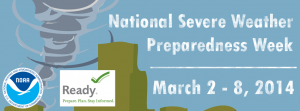This year, I am taking the time to learn how to prepare for severe weather during National Severe Weather Preparedness Week, March 2-8, 2014, sponsored by the Federal Emergency Management Agency (FEMA) and the National Oceanic Atmospheric Administration (NOAA).
Being prepared to act quickly could be a matter of survival. This is especially evident during the threat of severe weather. The deadliest and most destructive tornado of 2013, an EF-5 on May 20 in Moore, Oklahoma caused more than $2 billion in property damage. Even though severe weather was anticipated days in advance, many in the impacted areas said they did not have a plan and were caught unprepared. And while spring tends to produce more tornadoes, they’re not uncommon in fall. On Nov. 17, a late season tornado outbreak that struck seven Midwestern states became the most active tornado day of 2013 with a total of 74 tornadoes.
Here is what you can do to prepare:
Know Your Risk – Hurricanes, tornadoes and storms – every state in the United States experiences severe weather. Visit weather.gov to get the latest on weather threats.
Take Action – Take the next step in severe weather preparedness by creating a family communications plan, putting an emergency kit together, keeping important papers and valuables in a safe place and learning about Wireless Emergency Alerts.
Check out the Emergency Management Services page on the City’s website for other helpful hints and links to other preparedness organizations.
